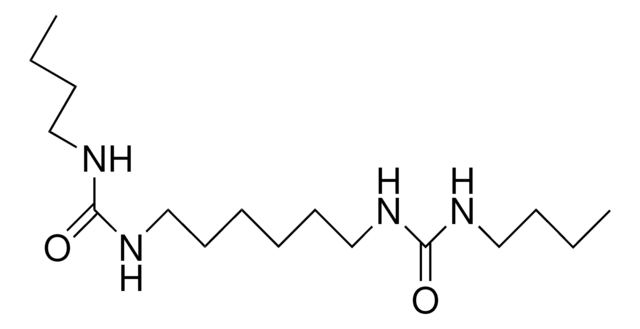All Photos(1)
About This Item
Linear Formula:
CH3(CH2)3NHCONH2
CAS Number:
Molecular Weight:
116.16
Beilstein/REAXYS Number:
1744775
EC Number:
MDL number:
UNSPSC Code:
12352100
PubChem Substance ID:
NACRES:
NA.22
Recommended Products
assay
99%
form
crystals
mp
95-98 °C (lit.)
SMILES string
CCCCNC(N)=O
InChI
1S/C5H12N2O/c1-2-3-4-7-5(6)8/h2-4H2,1H3,(H3,6,7,8)
InChI key
CNWSQCLBDWYLAN-UHFFFAOYSA-N
Looking for similar products? Visit Product Comparison Guide
Related Categories
Certificates of Analysis (COA)
Search for Certificates of Analysis (COA) by entering the products Lot/Batch Number. Lot and Batch Numbers can be found on a product’s label following the words ‘Lot’ or ‘Batch’.
Already Own This Product?
Find documentation for the products that you have recently purchased in the Document Library.
Joanna Krakowiak et al.
Journal of biological physics, 45(2), 161-172 (2019-03-25)
The results of thermal studies of denaturation of hen egg white lysozyme (HEWL) in water and an aqueous solution of N-butylurea (BU) are presented. High-precision densimetric measurements were used to characterize and analyze the changes of the specific volume, v
Peter L Larsen et al.
Journal of the American Chemical Society, 126(21), 6522-6523 (2004-05-27)
Metal complexes with terminal chalcogenido ligands are known for the early transition-metal complexes, yet for the heavier congeners (e.g., sulfido and selenido), there are no analogous examples for the late 3d metal ions. Reported herein is the isolation and characterization
Kevin X Chen et al.
Bioorganic & medicinal chemistry, 16(4), 1874-1883 (2007-11-23)
Starting from a pentapeptide Hepatitis C virus NS3 protease inhibitor, a number of alpha-ketoamide inhibitors based on novel dichlorocyclopropylproline P2 core were synthesized and investigated for their HCV NS3 serine protease activity. The key intermediate 3,4-dichlorocyclopropylproline was obtained through a
Srinivasan R Nagarajan et al.
Bioorganic & medicinal chemistry, 11(22), 4769-4777 (2003-10-15)
The human immunodeficiency virus (HIV) has been shown to be the causative agent for AIDS. The HIV virus encodes for a unique aspartyl protease that is essential for the production of enzymes and proteins in the final stages of maturation.
K Fujii et al.
Cancer letters, 18(3), 321-328 (1983-04-01)
A subcutaneous injection of 1-butyl-1-nitrosourea (BNU) at the maximum tolerated dose (333 mg/kg body wt.) to newborn CDF1 mice induced adenocarcinoma and adenoma of the lung, adenoma of the liver, thymic or non-thymic lymphoma and neurinoma of the acusticus nerve;
Our team of scientists has experience in all areas of research including Life Science, Material Science, Chemical Synthesis, Chromatography, Analytical and many others.
Contact Technical Service








